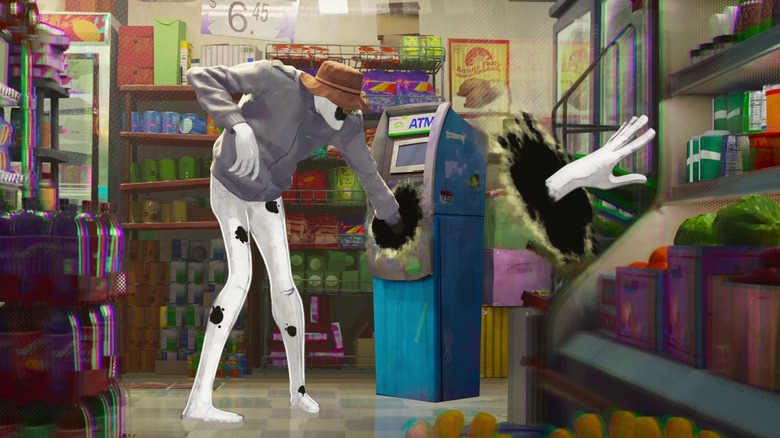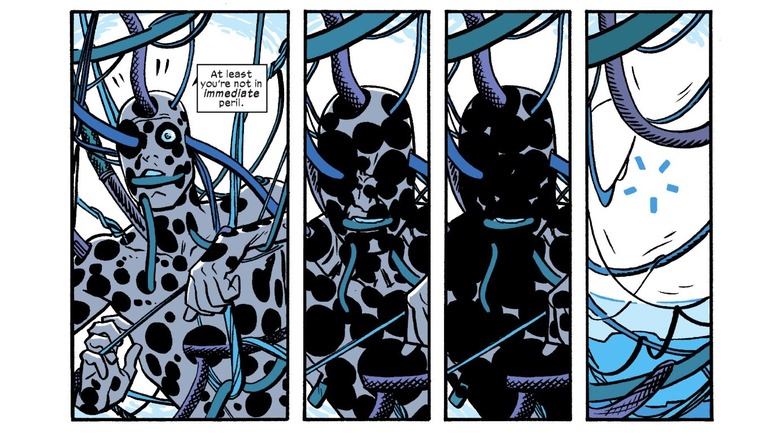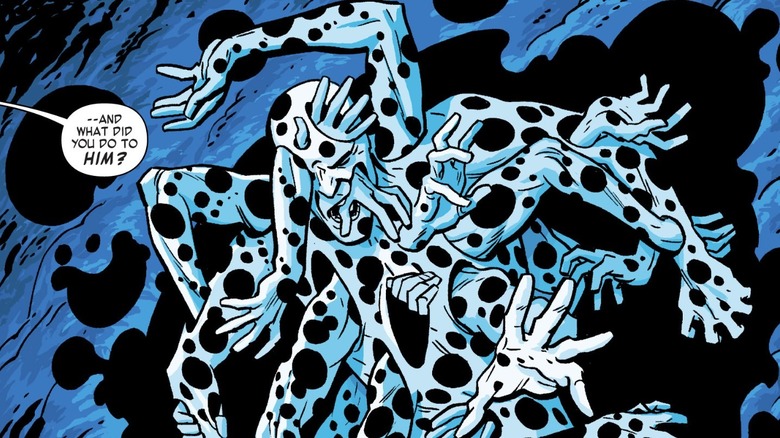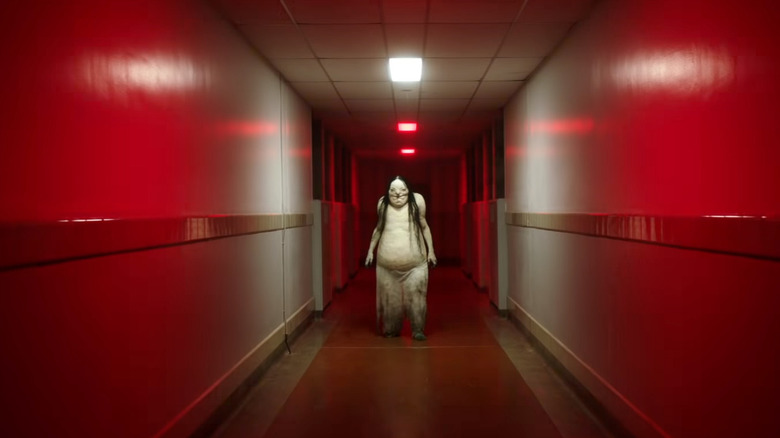The Spot's Final Form Could Bring Some Serious Cronenberg Vibes To The Spider-Verse
This article contains spoilers for "Spider-Man: Across the Spider-Verse."
Spider-Man has faced many foes on the big screen, but none of them have been quite so confusing to fight as The Spot. Voiced by Jason Schwartzman, this villain's big-screen debut in "Spider-Man: Across the Spider-Verse" sees him clumsily trying to use his new powers to rob an ATM (because the job market is unfairly hostile to candidates who have a void where their face should be).
We've seen characters that have the power to create portals before. In "X-Men: Days of Future Past," Blink (Fan Bingbing) used them to buy time during a doomed battle against the Sentinels. More recently, "Dungeons and Dragons: Honor Among Thieves" staged a daring heist that hinged on a portal spell. But animation might be the best medium for exploring the infinite possibilities of portals — as seen in the portal doors of "Monsters, Inc.," the Sea of Holes in "Yellow Submarine," and now the multiverse-hopping antics of the Spot in "Across the Spider-Verse."
The Spot doesn't just create portals, though — his whole body is covered in them. Try to punch him in the face and you could wind up punching yourself instead. While attempting to fight him, Miles repeatedly ends up sticking his limbs through his new nemesis instead, with visually mind-bending results. But nothing we see in the movie is quite as horrifying as the Spot's "final form" in the comics.
A spot of bother
If there's two things that filmmaker David Cronenberg loves, it's science experiments gone wrong and people growing extra orifices. While he might not be as visually grotesque as Jeff Goldblum's monstrous transformation in "The Fly" or James Woods' stomach hole in "Videodrome," the Spot is pretty conceptually horrifying, and that horror was fully exploited by writer Mark Waid and artist Chris Samnee in the 2012 Marvel Comics series "Daredevil: The Man Without Fear."
Issues #19-21 feature a villain called Coyote, who works for a mysterious organization that has captured the Spot and hooked him up to a machine in order to steal his powers. What does he use them for? Well, for starters, to remove Daredevil's head from his body while still keeping him alive, so he can listen to Coyote's evil monologue. Not only does Coyote have a whole collection of living severed heads stacked in a closet, he's also been smuggling illegal goods across the border using portals placed on women's stomachs. That's a particularly Cronenbergian visual.
Things really get twisted for the Spot when Daredevil sabotages the machine that his body is hooked up to. The Spot wrenches himself free and disappears, only to remerge as a terrifying tangle of protruding arms that crawls around like a caterpillar, hell-bent on exacting its revenge.
The Spot's final form
"Spider-Man: Across the Spider-Verse" has a mostly family-friendly PG rating due to "sequences of animated action violence, some language and thematic elements." But while the Spot starts out as quite a goofy villain, his yearning to be taken seriously as Miles' nemesis drives him across the multiverse in search of another super-collider like the one that originally transformed him. When he locates it, he tears a hole in Mumbattan and becomes much darker, scarier, and more powerful than before.
The movie's cliffhanger ending leaves Spider-Man still to face his final showdown with the Spot in "Spider-Man: Beyond the Spider-Verse," and since we've already seen this bad guy evolve once, it's possible he could try to level up again with another super-collider and end up accidentally twisting himself into the creature from the comics. Given the creativity of the animation in the first two movies, the idea of the Spot's final form being brought to life on the big screen is definitely enticing. But the Motion Picture Association might feel differently.
Rated R for 'really, really scary'
The MPA has pretty strictly defined rules around content like nudity and swearing, but when it comes to the scare factor, things get a little more subjective.
The PG-13 rating was originally created in response to movies like "Gremlins" and "Indiana Jones and the Temple of Doom," which were aimed at family audiences but contained violence and disturbing scenes that could be too much for younger kids. You might be surprised by some of the horror movies that have since managed to land a PG-13 rating. Gore Verbinski's "The Ring," often cited as one of the scariest movies of all time, is rated PG-13. So is André Øvredal's "Scary Stories to Tell in the Dark," despite containing pure nightmare fuel like the Pale Lady.
But there are some movies that have earned a higher rating for unconventional reasons. "The Conjuring" producer Walter Hamada says he was told by the MPA that, even though the movie contains very little bloody violence, it would have to be rated R because "it's just so scary. [There are] no specific scenes or tone you could take out to get it PG-13." Sci-fi classic "The Matrix" is also rated R, despite being largely bloodless, because of the excessive amount of gun violence.
The closest thing we've seen to the Spot's twisted final form on the big screen is the mannequin monster in "Silent Hill: Revelation," which was rated R ... but mostly for other reasons. Since the MPA considers not just the extremity of disturbing imagery, but also the amount of it, "Spider-Man: Beyond the Spider-Verse" could probably get away with bringing the Spot's most monstrous appearance to life if it was limited to a small portion of the movie. It could definitely make for one hell of a final battle.
"Spider-Man: Across the Spider-Verse" is currently in theaters.



